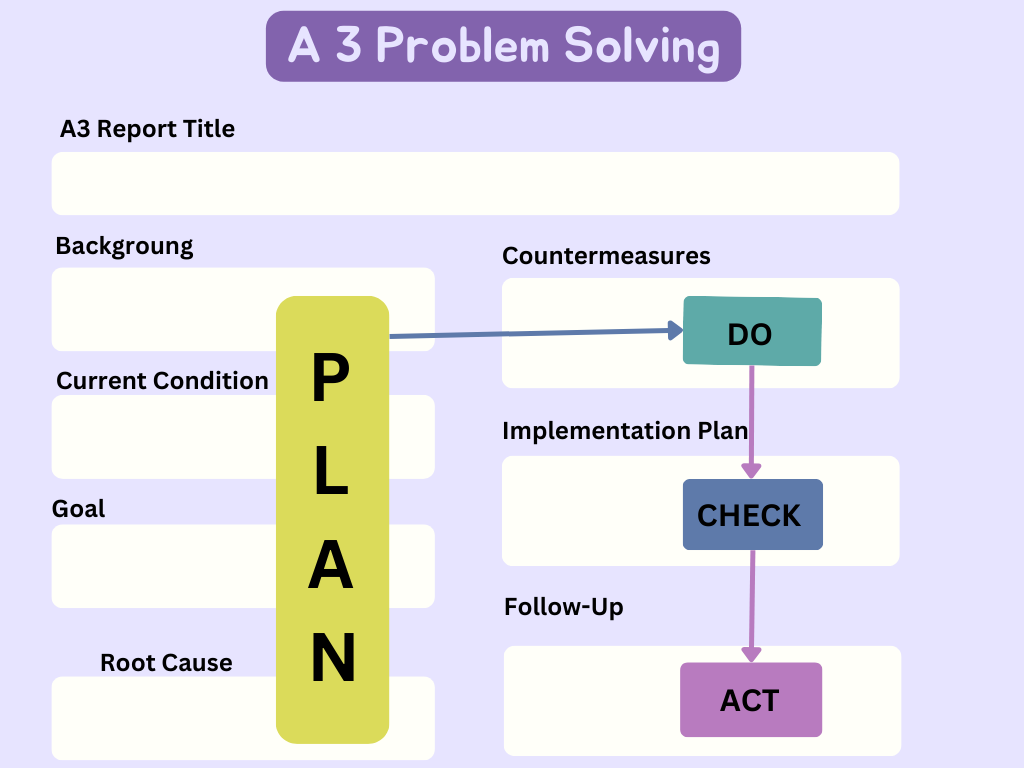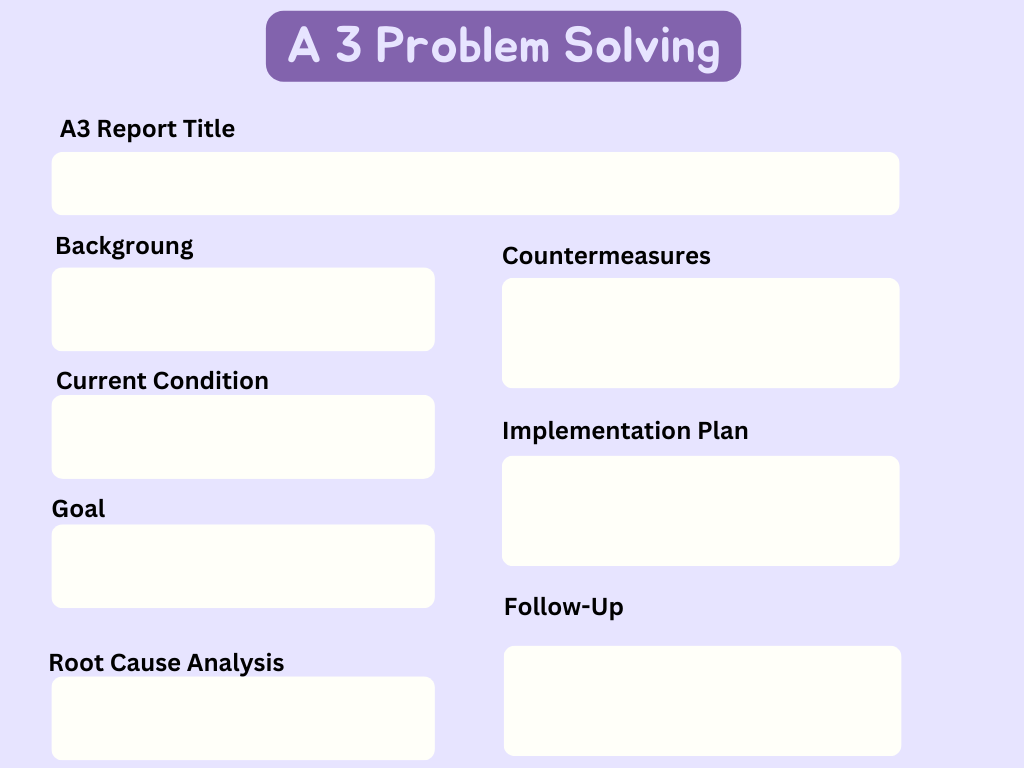1. What is the A3 Problem Solving Method?
The A3 problem-solving method is a structured approach to solving problems that focuses on continuous improvement and lean thinking. It uses a one-page document, typically on A3-sized paper (297 x 420 mm), to document the problem, analysis, and proposed solutions. This method encourages clear, concise, and visual communication of the problem-solving process.

2. What are the Types of A3 Problem Solving?
The types of A3 problem-solving typically include:
Problem Solving A3: Used for addressing and solving specific problems.
Proposal A3: Used to propose new ideas or projects.
Status Report A3: Used to report on the current status of a project or process.
Strategic Planning A3: Used for strategic planning and setting long-term goals.
3. What is the A3 Method of Problem Solving?
The A3 method of problem-solving involves a structured approach using the following steps:
Background: Define the problem's context and importance.
Current Condition: Describe the current state with data and visuals.
Goal: Define the target state or desired outcome.
Root Cause Analysis: Identify the root causes of the problem.
Countermeasures: Propose solutions to address the root causes.
Implementation Plan: Outline steps to implement the solutions.
Follow-Up: Plan for tracking progress and measuring effectiveness.
4. What is an A3 in Six Sigma?
In Six Sigma, an A3 is used as a tool for problem-solving and continuous improvement, aligning with Six Sigma's DMAIC (Define, Measure, Analyze, Improve, Control) methodology. It provides a structured way to document and communicate each phase of the problem-solving process.
5. What is the Difference Between A3 and DMAIC?
A3 Problem Solving: A lean approach focused on a single-page, visual method for problem-solving and continuous improvement.
DMAIC: A Six Sigma methodology consisting of five phases (Define, Measure, Analyze, Improve, Control) for process improvement and problem-solving.
6. What is the A3 Report for DMAIC?
An A3 report in the context of DMAIC would document the problem-solving process through each DMAIC phase on a single A3-sized page, providing a concise and visual summary.

7. What is the Scope of A3 Problem Solving?
The scope of A3 problem-solving includes:
- Addressing specific problems.
- Improving processes.
- Proposing new ideas or projects.
- Reporting status and progress.
- Strategic planning and long-term goal setting.
8.What is A3 Thinking Root Cause Analysis?
A3 thinking root cause analysis involves using tools like the "5 Whys" and Fishbone Diagrams to identify the fundamental reasons for a problem. This analysis is a critical part of the A3 problem-solving process.
9. Is A3 a Kaizen Event?
A3 problem-solving can be part of a Kaizen event, which is a focused, short-term project to improve a process. However, A3 itself is not limited to Kaizen events and can be used independently for various types of problem-solving and improvement initiatives.
10. Is Kaizen a DMAIC?
Kaizen and DMAIC are both continuous improvement methodologies but are not the same. Kaizen focuses on incremental, continuous improvement involving everyone in the organization, while DMAIC is a structured, data-driven methodology specific to Six Sigma for improving processes.
11. What is the A3 in Agile?
In Agile, an A3 can be used for problem-solving, planning, and communicating improvement initiatives in a concise and visual manner, aligning with Agile's emphasis on collaboration and iterative improvement.
12. What is the Difference Between DMAIC and A3?
DMAIC: A structured Six Sigma methodology for process improvement, involving five phases.
A3: A lean problem-solving tool focusing on concise, visual documentation and continuous improvement.
13. What is A3 Technique in Six Sigma?
The A3 technique in Six Sigma is used for documenting and communicating the problem-solving process in a visual, concise format, supporting the DMAIC methodology.
14. What is A3 in Lean Thinking?
In lean thinking, A3 is a tool for problem-solving and continuous improvement, emphasizing clarity, visual communication, and iterative progress.
15. What is the A3 Strategic Plan?
An A3 strategic plan is a single-page document outlining the strategic objectives, goals, actions, and metrics for an organization or project, providing a clear and visual roadmap for achieving long-term success.
16. What is A3 Quality Improvement?
A3 quality improvement involves using the A3 methodology to systematically address quality issues, identify root causes, implement solutions, and monitor progress to enhance overall quality.
17. When to Use A3 Problem Solving?
Use A3 problem solving when:
- Addressing complex problems requiring a structured approach.
- Communicating problem-solving processes clearly and concisely.
- Engaging team members in collaborative problem-solving.
- Implementing continuous improvement initiatives.
18. What are the Benefits of A3 Thinking?
The benefits of A3 thinking include:
- Clarity and conciseness in problem-solving documentation.
- Enhanced communication and collaboration among team members.
- Visual representation of the problem-solving process.
- Focus on root causes and effective countermeasures.
- Support for continuous improvement and lean thinking.